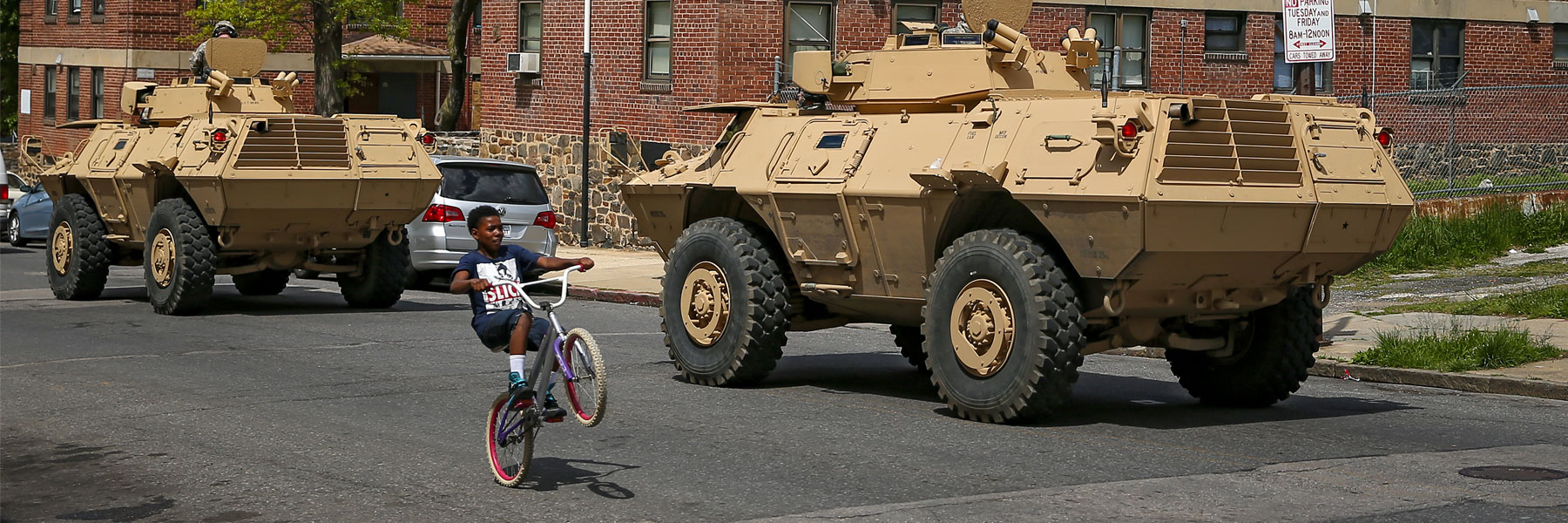
If You Thought Obama Was Giving Less Military Gear to Local Police Departments, You Were Wrong
Despite President Obama's much-touted 2015 executive order, an In These Times investigation reveals evidence that police departments are still receiving as much military hardware from the Pentagon as ever.
OCTOBER ISSUE | September 16, 2016
When protestors took to the streets of Ferguson, Mo., in 2014 in response to the police killing of 18-year-old Michael Brown, they also turned the nation’s attention to a related issue: the growing militarization of local law enforcement. Images of suburban police threatening demonstrators with armored vehicles and assault rifles prompted changes to the controversial 1033 program, through which the Department of Defense (DOD) transfers surplus military equipment to police departments nationwide.
President Obama’s May 2015 announcement that he would freeze giveaways of certain gear drew outrage from law enforcement groups such as the National Association of Police Organizations (NAPO), which later charged that the banned equipment was “essential in protecting communities against violent criminals and terrorists.” After shooters targeted and killed uniformed police officers in Dallas and Baton Rouge in July, NAPO and other groups doubled down on criticisms that the administration was putting officers’ lives at risk. On July 21, Reuters reported that, following a meeting with police groups, Obama had agreed to revisit the ban.
But an In These Times investigation provides evidence that, in practice, the president’s much-ballyhooed reforms to the 1033 program have done little to stem the flow of battlefield gear to cops.
In fact, the total value of equipment distributed through the program actually increased in the year following the ban, according to figures provided to In These Times by Michelle McCaskill, media relations chief for the DOD's Defense Logistics Agency (DLA), which oversees the shipments.
So far in fiscal year 2016, (Oct. 1, 2015 - September 13), the DLA has transferred $494 million worth of gear to local police departments, In These Times learned from McCaskill.
That far exceeds the $418 million of equipment sent to police in FY 2015 (Oct. 1, 2014 - Sept. 30, 2015). According to an analysis published in May by the transparency organization Open the Books, 2015 was already a peak year for such shipments within the past decade, exceeded only by 2014's $787 million. Since 2006, more than $2.2 billion of hardware has found its way into the hands of police, according to the report.
Many police accountability advocates warned from the outset that last year’s reforms were too limited in scope. Of seven items on the list of prohibited equipment, only one had actually been given to police departments in recent years, noted a May 2015 article in the Guardian. While the Obama administration placed additional requirements on the transfer of certain aircraft, armored vehicles and riot gear considered especially intimidating to civilians, hundreds of pieces of such equipment are still finding their way into the hands of local police. So far this year, for example, cops have acquired more than 80 mine-resistant ambush protected vehicles (MRAPs)—15-ton vehicles that were originally designed to withstand roadside bombs in war zones.
A second life for lethal weaponry
The 1033 program, which refers to a section of the 1997 National Defense Authorization Act that created it, is a popular way for cash-strapped local law enforcement agencies to get gear on the cheap. Police departments typically are responsible only for the costs of shipping and maintaining the equipment.
Advocates also say the 1033 program allows underutilized Pentagon inventory to find a second life. “Since the American taxpayers have paid for this equipment already, does it not make more sense to share this equipment with local law enforcement agencies, as opposed to asking for the taxpayers to buy the same equipment twice?” asks Jim Franklin, executive director of the Minnesota Sheriffs’ Association, in an email to In These Times.
ACLU Minnesota legal director Teresa Nelson says that she is sensitive to the needs of law enforcement. “Nobody wants the police to be unsafe,” she says. “At the same time … when you have police in armored vehicles that look like tanks, you really change the dynamic between the police and the communities they serve.”
In January 2015, Obama responded to growing criticism of the program in the wake of Ferguson by issuing Executive Order 13688, which created a federal interagency group to investigate police militarization and come up with recommendations. As a result of this investigation, police were prohibited from receiving certain equipment, including bayonets, tracked armored vehicles, firearms and ammunition of .50‐caliber or higher, grenade launchers, camouflage uniforms and weaponized aircraft.
Critics said the reforms were superficial. Last year, an NPR analysis of 10 years of DLA data showed that of all the aircraft given to local police through the 1033 program, none were weaponized. The investigation further revealed that nearly 87 percent of the hundreds of armored vehicles being used at the time by local police ran on wheels, not tracks. Peter Kraska, a professor at Eastern Kentucky University’s School of Social Justice Studies and one of the leading researchers of police militarization, told the Guardian that the new rules were nothing more than a “publicity stunt.”
The ongoing transfer of armored vehicles, such as MRAPs, epitomizes these criticisms. Since the vehicles run on wheels, they aren’t on the new list of banned transfers. Nevertheless, their heft and design for use in warfare illustrates what critics see as the increasingly blurry line between police and military.
According to the DLA, police departments have received 708 MRAPs through the 1033 program since 2011, when the drawdown of troops in Iraq and Afghanistan first created a large reserve of unused equipment. At press time, 84 police departments had received the armored vehicles this year. More than 100 others have been approved and are awaiting delivery, according to DLA records obtained by In These Times through a Freedom of Information Act request.
As part of the Obama administration’s reforms, law enforcement agencies receiving “controlled” items, such as MRAPs, must demonstrate that they plan to train officers on proper use. But training materials used by various California police departments, obtained by the website MuckRock in June, show that instructional time for MRAPs ranges from 20 hours to as little as 15 minutes.
Coming to a town near you?
Previously, only large urban police departments would have had the resources to justify acquiring the armored vehicles, which can cost upwards of $1 million. In 2014, Bill Johnson, executive director of NAPO, told USA Today that the 1033 program allows smaller police forces to play catch-up: “It’s their turn to get some of this equipment.”
That may explain why the 1033 program is particularly popular in states with significant rural populations such as Minnesota, where 74 of 87 county sheriffs have received surplus military equipment since 2005—mostly assault rifles and armored vehicles.
Jason Dingman, sheriff of sparsely populated Stevens County, Minn., told In These Times that an MRAP arrived this summer with only 56 miles on it. Virtually brand-new, the armored vehicle will just need a paint job and a fresh battery before being ready for use by West Central SWAT—a multi-agency task force that carries out tactical operations along the South Dakota border, but is called to the scene just six to eight times per year. “If we’re just executing a search warrant then we won’t bring [the MRAP] out,” Dingman says.
“But if the bad guy starts shooting at us then it’s a different situation and we can call out the MRAP to give our officers more protection.”
The DLA’s data show that police agencies receiving MRAPs in 2016 included those serving such tiny municipalities as Fallon, Nev. (pop. 8,458), and Westwego, La. (pop. 8,542). Even the police force in rural Pigeon Forge, Tenn. (pop. 6,171), found the need for an MRAP—perhaps to more effectively repel potential terrorist attacks on Dollywood, the town’s Dolly Parton-themed amusement park.
While police contend that equipment such as MRAPs are used defensively, renewed concerns arise whenever protests are met with a show of force. Following the police killing of Alton Sterling in Baton Rouge in July, a local reporter videotaped an armored vehicle pushing up against a crowd of protestors.
John Lindsay-Poland, who has researched the topic for the anti-militarism group American Friends Service Committee, thinks that the 1033 program fosters a “warrior mentality” that can further corrode police-community relations. “If we do not want our police to be at war in our communities,” he tells In These Times, “then we shouldn’t equip them with war-fighting equipment.” 
Investigative stories like this are only possibly because of the support of readers like you. If you want to see more hard-hitting journalism, make a tax-deductible donation to support In These Times.

From the November 2016 Issue
Seth Kershner is a writer and researcher whose work has appeared in outlets such as Rethinking Schools, Sojourners, and Boulder Weekly. He is the co-author (with Scott Harding) of Counter-Recruitment and the Campaign to Demilitarize Public Schools (Palgrave Macmillan, 2015).
Get more of what the mainstream media leaves out: Subscribe to the free In These Times weekly newsletter:
